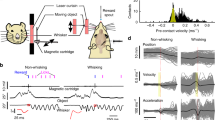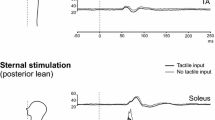Summary
-
1.
The influence of mechanosensory stimulation of a second segment swimmeret upon the abdominal postural program was examined in an isolated abdominal nerve cord-swimmeret preparation. The swimmeret was stimulated in several different ways to assess the extent of influence exerted on abdominal positioning.
-
2.
Localized tactile stimulation of the swimmeret surface with a mechanical probe usually generated flexion inhibition where the flexor inhibitor (f5) was activated while the small and medium flexor excitors were inhibited (Figs. 4, 5). Flexion inhibition was much stronger in females than males. In 50% of the animals a weak flexion excitation was seen (Fig. 6). After 3–6 hours the response of one-third of these preparations changed to flexion inhibition.
-
3.
Strong manual stimulation of the swimmeret surface inhibited all of the flexor excitors (f1, f2, f3, f4, and f6) while exciting the inhibitor f5 and increasing extensor activity (Fig. 11). Similar extension responses were observed in both sexes.
-
4.
Repeated tactile stimulation of the swimmeret surface elicited a response similar to that evoked during manual stimulation. The strongest extension response was produced at 2 Hz which falls within the normal range of swimmeret beating in intact lobsters (Figs. 8, 9). Similar extension responses were also obtained during spontaneous swimmeret beating and rhythmic manual movement of the swimmeret (Fig. 10A, C).
-
5.
The interganglionic spread of postural responses and their long latencies imply the involvement of a population of interneurons that are affected by tactile stimulation of the swimmeret and which in turn form part of the integrative network that controls abdominal posture.
Similar content being viewed by others
References
Berrill M (1974) The burrowing behavior of newly settledHomarus vulgaris. J Mar Biol Assoc UK 54:797–801
Bush BMH (1965) Leg reflexes from chordotonal organs in the crab,Carcinus maenas. Comp Biochem Physiol 15:567–587
Bush BMH, Laverack MS (1982) Mechanoreception. In: Atwood HL, Sandeman DC (eds) The biology of Crustacea. Academic Press, London New York, pp 399–468
Cattaert D, Clarac F (1983) Influence of walking on swimmeret beating in the lobsterHomarus gammarus. J Neurobiol 14:421–439
Cobb JS (1971) The shelter-related behavior of the American lobster,Homarus americanus. Ecology 52:108–115
Cole WH (1941) A perfusing solution for the lobster (Homarus) heart and the effects of its constituent ions on the heart. J Gen Physiol 25:1–6
Davis WJ (1968) Lobster righting responses and their neural control. Proc R Soc Lond [Biol] 170:435–456
Davis WJ (1969) Reflex organization in the swimmeret system of the lobster II. Reflex dynamics. J Exp Biol 51:565–573
Davis WJ (1971) The integrative action of the nervous system in crustacean equilibrium reactions. In: Gordon SA, Cohen MJ (eds) Gravity and the organism. University of Chicago Press, Chicago, pp 237–250
Davis WJ (1973) Neuronal organization and ontogeny in the lobster swimmeret system. In: Stein RB, Pearson KG, Smith RS, Redford JB (eds) Control of posture and locomotion. Plenum, New York London, pp 437–455
Evoy WH, Kennedy D (1967) The nervous organization underlying control of antagonistic muscles in the crayfish I. Types of command fibers. J Exp Zool 165:223–238
Farmer AS (1974) The development of the external sexual characters ofNephrops norvegicus (L.) (Decapoda: Nephropidae). J Nat Hist 8:241–255
Fields HL (1976) Crustacean abdominal and thoracic muscle receptor organ. In: Mill PJ (ed) Structure and function of proprioreceptors in the invertebrates. Chapman and Hill, London, pp 65–114
Grobstein P (1973) Extension-sensitivity in crayfish abdomen. I. Neurons monitoring nerve cord length. J Comp Physiol 86:331–348
Harris-Warrick RM (1985) Amine modulation of extension command element-evoked motor activity in the lobster abdomen. J Comp Physiol A 156:875–884
Heitler WJ (1982) Nonspiking stretch-receptors in the swimmeret system. J Exp Biol 96:355–366
Heitler WJ (1985) Motor programme switching in the crayfish swimmeret system. J Exp Biol 114:521–549
Herrick FH (1895) The American lobster, a study of its habits and development. Bull US Fish Commun 15:1–252
Herrick FH (1909) Natural history of the American lobster. Bull US Bur Fish 29:149–408
Hughes GM, Wiersma CAG (1960) Neuronal pathways and synaptic connections in the abdominal cord of the crayfish. J Exp Biol 37:291–307
Jellies J, Larimer JL (1984) Tactile activation of interneurons which produce abdominal movements in crayfish. Soc Neurosci Abstr 10:626
Jellies J, Larimer JL (1985) Synaptic interactions between neurons involved in the production of abdominal posture in crayfish. J Comp Physiol A 156:861–873
Jones KA, Page CH (1984) Output properties of premotor intersegmental interneurons in the postural system of lobster. Soc Neurosci Abstr 10:626
Kennedy D, Takeda K (1965) Reflex control of abdominal flexor muscles in the crayfish I: The tonic system. J Exp Biol 43:211–227
Kennedy D, Evoy WH, Fields HL (1966) The unit basis of some crustacean reflexes. Symp Soc Exp Biol 20:75–109
Killian KA, Page CH, Cippolla DA (1986) Efferent neurons of the abdominal pleopods in the lobster,Homarus americanus. Soc Neurosci Abstr 11:511
Larimer JL, Eggleston AC (1971) Motor programs for abdominal positioning in crayfish. Z Vergl Physiol 74:388–402
Larimer JL, Moore D (1984) Abdominal positioning interneurons in crayfish: Projections to and synaptic activation by higher CNS centers. J Exp Zool 230:1–10
Laverack MS (1976) External proprioreceptors. In: Mill PJ (ed) Structure and function of proprioreceptors in the invertebrates. Chapman and Hill, London, pp 1–63
Pabst H, Kennedy D (1967) Cutaneous mechanoreceptors influencing motor output in the crayfish abdomen. Z Vergl Physiol 57:190–208
Page CH (1982) Control of posture. In: Sandeman DC, Atwood HL (eds) The biology of Crustacea, vol II. Academic Press, New York, pp 33–54
Page CH (1985) Sexual dimorphism of pleopod motor neurons in lobster. Brain Res 339:154–157
Page CH, Jones KA (1982) Abdominal motoneuron responses elicited by flexion of a crayfish leg. J Exp Biol 99:339–347
Page CH, Gadaleta D, Iacopino A (1984) Temporal and spatial spread of an intersegmental reflex in crayfish. J Exp Biol 113:109–122
Paul DH, Mulloney B (1985) Local interneurons in the swimmeret system of the crayfish. J Comp Physiol A 156:489–502
Thompson CS, Page CH (1982) Command fiber activation of superficial flexor motoneurons in the lobster abdomen. J Comp Physiol 148:515–527
Wine JJ (1984) The structural basis of an innate behavioral pattern. J Exp Biol 112:283–319
Wine JJ, Mittenthal JE, Kennedy D (1974) The structure of tonic flexor motoneurons in crayfish abdominal ganglia. J Comp Physiol 93:315–335
Author information
Authors and Affiliations
Rights and permissions
About this article
Cite this article
Kotak, V.C., Page, C.H. Tactile stimulation of the swimmeret alters motor programs for abdominal posture in the lobsterHomarus americanus . J. Comp. Physiol. 158, 225–233 (1986). https://doi.org/10.1007/BF01338565
Accepted:
Issue Date:
DOI: https://doi.org/10.1007/BF01338565




